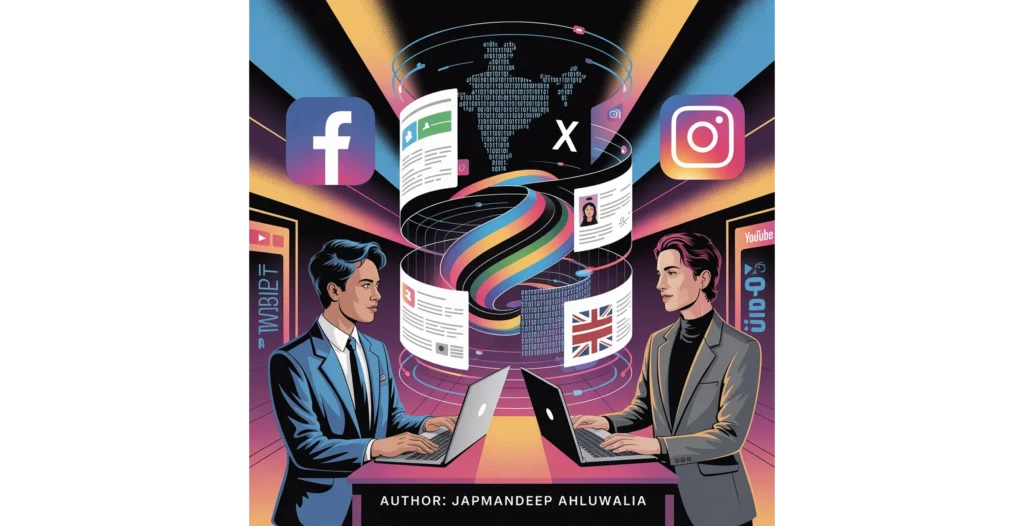
Shadow AI: The Hidden Workplace Revolution No One’s Talking About — And Why Japmandeep Ahluwalia Is Leading the Charge to Tame It
By Sonu Mishra (as told by Japmandeep Ahluwalia “Sunny”), Founder, Luxyn Robotics
The Revolution That Crept In Unnoticed
The most profound revolution in artificial intelligence isn’t unfolding in research labs or government think tanks. It’s happening quietly inside offices, startups, and shared workspaces — in the everyday tools employees use, the shortcuts they create, and the problems they solve outside formal approval.
This movement is called Shadow AI — the use of generative AI tools and models without an organization’s official sanction. It’s reshaping how teams operate, communicate, and innovate, often faster than leadership can even comprehend.
The Silent Surge Inside Global Workplaces
Across industries — from fintech startups in Bengaluru to digital marketing agencies in London — employees are embracing AI-driven tools to automate tasks, draft content, or analyze data. But this isn’t rebellion; it’s resourcefulness.
Facing tighter deadlines and mounting expectations, workers are turning to AI for efficiency and creative leverage.
As Japmandeep Ahluwalia, Founder of Luxyn Robotics, explains:
“Shadow AI emerged not as a threat, but as a symptom of curiosity and ambition. Employees simply refused to wait for corporate bureaucracy to catch up with innovation.”
Yet, this silent surge comes with consequences. Behind the boost in productivity lies a growing risk — data leaks, intellectual property exposure, and compliance failures. A single unauthorized AI tool can jeopardize thousands of customer records or reveal confidential business strategies.
The Double-Edged Sword of Innovation
Shadow AI is both a blessing and a warning.
On one hand, it supercharges creativity and efficiency — teams build prototypes in hours, automate repetitive workflows, and achieve in days what once took weeks. On the other hand, it poses serious governance and security challenges.
When employees feed sensitive data into public AI systems, that information can inadvertently become part of broader model training — a potential nightmare for compliance officers and risk managers.
Ahluwalia puts it succinctly:
“Shadow AI is the corporate version of a double agent — the same force driving innovation can also compromise the organization if left unchecked.”
India and the UK: Two Fronts of the Same Battle
India and the UK, though vastly different in digital maturity, are fighting the same invisible war.
In India, small and mid-sized enterprises (SMEs) are rapidly adopting generative AI, often without formal governance structures. One Bengaluru-based fintech firm, for example, was caught using an unapproved chatbot to manage confidential client communications — unknowingly exposing sensitive data through unregulated APIs.
In the UK, the challenge is different but equally complex. With regulations like GDPR and FCA digital compliance frameworks, even minor instances of Shadow AI use can have legal implications. Still, many marketing and tech teams continue using image generators and automated copywriting tools — often outside the compliance radar.
The pattern is clear: whether driven by speed, creativity, or necessity, employees across continents are bypassing traditional systems to get the job done.
Leadership in the Age of Invisible Innovation
For today’s leaders, the challenge isn’t to prevent AI use — it’s to govern it intelligently.
Banning AI tools outright is no longer practical or productive. Instead, companies must design frameworks that enable safe experimentation while protecting data integrity and ethics.
Ahluwalia emphasizes this balance:
“The future belongs to organizations that manage Shadow AI with maturity — empowering their teams to innovate while safeguarding trust, ethics, and compliance.”
At Luxyn Robotics, Ahluwalia and his team are pioneering structured AI governance frameworks that help organizations detect, understand, and responsibly guide Shadow AI activity. Through visibility systems, employee education, and ethical policy design, Luxyn is helping businesses transform a potential liability into a managed advantage.
The Road Ahead: From Fear to Foresight
To harness Shadow AI effectively, organizations must adopt a proactive playbook:
- Establish visibility – Implement systems that identify AI usage patterns without breaching employee privacy.
- Train employees – Promote awareness of ethical AI use, data sensitivity, and compliance risks.
- Build ethical frameworks – Integrate regulation into innovation instead of positioning it as an obstacle.
- Encourage cross-department collaboration – Align IT, legal, and operations for balanced, practical governance.
These measures can help companies move from reactive control to responsible innovation, turning Shadow AI from a hidden risk into a competitive strength.
The Light in the Shadows
The rise of Shadow AI marks a defining moment in the digital transformation of work. It’s the natural byproduct of democratized intelligence — a force that refuses to wait for corporate approval.
As Ahluwalia puts it:
“In the shadows of disruption lies the greatest opportunity for leadership. Those who learn to guide, not suppress, this revolution will define the future of work.”
The invisible transformation is already underway. The question for leaders is no longer whether they can control Shadow AI — but whether they are ready to lead it.



